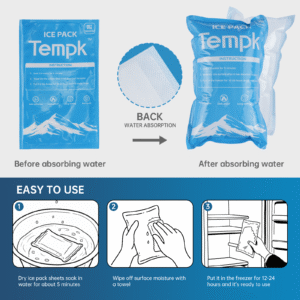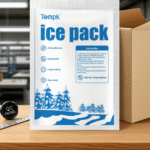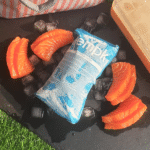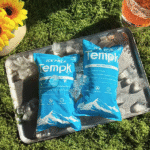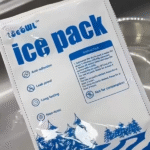¿Qué sucede si se moja una bolsa de hielo seco?? Seguridad & Corrección
cuando un la bolsa de hielo seco se moja, oleadas de sublimación, El gas CO₂ se acumula más rápido, y espera que el tiempo caiga. Si una bolsa de hielo seco se moja dentro de un recipiente sellado, La presión puede aumentar y crear riesgos de seguridad.. necesitas rapido, Pasos simples que estabilizan la temperatura., mantener el cumplimiento, y mantener a la gente segura. Un kilogramo de hielo seco produce ~541 litros de gas CO₂, entonces la ventilación no es negociable.
-
Por qué se moja una bolsa de hielo seco y qué pasa después (condensación y transferencia de calor)
-
Cómo solucionar la situación cuando una bolsa de hielo seco se moja durante el transporte
-
Cómo prevenir eventos de bolsas de hielo seco húmedo con un mejor empaque y diseño
-
2025 Materiales y sensores que reducen el riesgo de humedad.
¿Por qué se moja una bolsa de hielo seco y qué sucede después??
Respuesta corta: El agua es una autopista de calor: cuando se moja una bolsa de hielo seco, la sublimación se acelera.
La condensación se forma tan caliente, El aire húmedo se encuentra con una superficie fría.. Si el agua líquida toca el hielo seco, La transferencia de calor aumenta dramáticamente y la liberación de CO₂ aumenta. Espere un empañamiento más rápido, Duración de enfriamiento más corta, y mayor presión interna si las rejillas de ventilación están bloqueadas.
La humedad en la película o en la cavidad se convierte en un puente térmico.. Verás sudando, costras heladas, y las etiquetas se aflojan. En revestimientos sellados, La presión aumenta a medida que se acumula CO₂.. En espacios reducidos, ese gas puede desplazar el oxígeno; mantenga siempre el área ventilada.
¿Cuánto CO₂ se libera cuando se moja una bolsa de hielo seco??
Una bolsa de hielo seco que se moja libera CO₂ mucho más rápido.
1 lb de hielo seco genera aproximadamente 250 L de CO₂; 1 kg genera ~541 L. Eso puede deformar el embalaje o reventar las costuras si se sella el revestimiento.. Utilice pliegues ventilables o microperforaciones.; nunca anude ni selle con calor un revestimiento.
| Escenario de exposición | Tarifa estimada | Nivel de riesgo | Impacto en el envío |
|---|---|---|---|
| Seco, bien ventilado | Lento | Bajo | Tiempo de espera predecible |
| aire húmedo | Moderado | Medio | Duración de enfriamiento ligeramente más corta |
| Contacto directo con el agua | Lo más rápido | Alto | Aumento de presión y pérdida de temperatura. |
Consejos prácticos cuando se moja una bolsa de hielo seco
-
si en el interior: Muévase a un área ventilada; pliegues abiertos del revestimiento; limpiar la humedad; reemplazar los insertos empapados.
-
Durante la carga: Agregue una barrera de vapor alrededor de la carga útil y asegúrese de que el compartimiento de hielo pueda ventilarse.
-
si es frecuente: Agregue protectores contra salpicaduras o use aislamiento de mayor calidad diseñado para carriles húmedos.
Ejemplo de caso: Un laboratorio farmacéutico descubrió que reemplazar las bolsas sin forro con revestimientos compuestos resistentes a la humedad prolongaba el tiempo de mantenimiento de la temperatura en 24 horas en rutas de 72 horas.
¿Qué debe hacer si una bolsa de hielo seco se moja durante el transporte??
actúa rápido: ventilar, verificar las rutas de ventilación, quitar el agua, reemplazar componentes húmedos, y documento para el cumplimiento.
Su objetivo es restaurar el rendimiento térmico y mantener la seguridad..
-
Ventilar el área — El CO₂ es más pesado que el aire..
-
Comprobar la ventilación — nunca selle el hielo seco en un recipiente hermético.
-
Quitar agua libre — Seque las superficies con un paño.
-
Reemplazar aislamiento — las fibras húmedas conducen el calor rápidamente.
-
Reetiquetar — utilice materiales aptos para congeladores.
-
Detalles del registro - tiempo, ubicación, y acciones correctivas.
| Paso | Razón | Tiempo necesario | Beneficio |
|---|---|---|---|
| Ventilación | Previene la acumulación de gases | 1–2 minutos | Seguridad ante todo |
| Verificar la ventilación | Evita la rotura del liner | 1 mínimo | Cumplimiento |
| Eliminar la humedad | Reduce la transferencia de calor | 3 mínimo | Enfriamiento más prolongado |
| Reemplazar inserciones | Restaura el aislamiento | 5 mínimo | Temperatura estable |
Cómo evitar un escenario en el que “la bolsa de hielo seco se moja”
Controlar la humedad, embalaje previo a la condición, y diseño para ventilación.
Mantenga las salas de embalaje debajo 40% RH, transportistas preenfriados, y usar revestimientos hidrofóbicos. Evite empacar demasiado: deje espacio de ventilación encima del refrigerante.
| Consejo de prevención | Método | Resultado |
|---|---|---|
| Control de humedad | Deshumidificar las salas de embalaje | Menos condensación |
| Preacondicionamiento | Enfriar cajas antes de cargar | Reduce la formación de rocío |
| Actualización del revestimiento | Utilice una película multicapa hidrófoba | Detiene la humedad directa |
| Ventilación adecuada | Doblar, no sellar, tapas del trazador de líneas | Previene el exceso de presión |
2025 Desarrollos y tendencias que importan.
Las nuevas tecnologías de envasado facilitan la prevención de daños por humedad. Los sensores inteligentes de CO₂ y humedad pueden detectar cuando una bolsa de hielo seco se moja antes de que comprometa el tiempo de retención. Los transportistas VIP y los contenedores de circuito cerrado amplían la retención del frío y minimizan el desperdicio.
Últimas innovaciones
-
Embalaje con sensor integrado – envía alertas cuando aumentan los niveles de humedad o CO₂
-
Revestimientos hidrofóbicos – repele el agua sin atrapar gases
-
Sistemas reutilizables – reducir el desperdicio y mantener un rendimiento constante
Insight del mercado: La adopción global de soluciones de cadena de frío inteligentes y sostenibles está aumentando a medida que aumentan las presiones de cumplimiento y eficiencia..
Preguntas frecuentes
¿Es peligroso si se moja una bolsa de hielo seco??
Sí. La liberación más rápida de CO₂ puede desplazar el oxígeno y crear presión. Mantenga los paquetes ventilados.
¿Por qué aparece niebla cuando se moja una bolsa de hielo seco??
El calor del agua impulsa una rápida sublimación, y el gas condensa la humedad en el aire.
¿Puedo reutilizar un delineador después de que se moje y se congele??
Sólo si no se ha agrietado y todavía ventila de forma segura.
¿Debo sellar un revestimiento húmedo para evitar la entrada de agua??
No. Deje la ventilación abierta; en su lugar, selle la humedad al nivel de la carga útil..
¿Cuánto gas se produce??
Acerca de 250 litros por libra, o 541 L por kilogramo de hielo seco.
Resumen y recomendaciones
Cuando se moja una bolsa de hielo seco, la sublimación se acelera, El CO₂ aumenta, y la eficiencia del aislamiento cae.
Ventile inmediatamente, verificar las rutas de ventilación, eliminar la humedad, y reemplazar las piezas dañadas.
Prevenir la recurrencia mediante el control de la humedad., mejores materiales de revestimiento, y entrenamiento.
Siguientes pasos:
Audite sus SOP, actualizar a revestimientos resistentes a la humedad, y probar sensores de CO₂ en rutas húmedas.
Necesita soluciones personalizadas? Consulte a un especialista de Tempk para una auditoría de embalaje.
Acerca de Tempk
Tempk diseña y prueba empaques de cadena de frío que siguen cumpliendo con las normas y son confiables, incluso cuando las condiciones son húmedas..
Nuestro equipo combina la ciencia del embalaje con experiencia en logística para ampliar los tiempos de espera y cumplir 2025 normas regulatorias.
Ayudamos a clientes globales a reducir el deterioro, mejorar la seguridad, y lograr un control de temperatura sostenible.






